Bed Bounce: The Clock Is Ticking
Based on the response from the last two posts, we’ve come to the realization that the Tundra has an issue with bed bounce. While it’s still unclear exactly how many people are affected, considering the demonstrated severity of this issue we feel it is important to discuss.
Without going into details (at this time), we’ve contacted Toyota and requested an official response to the bed bounce issue. We’re not exactly sure when Toyota will respond, but we hope it is very soon. As one of the only websites on the internet focused on the new Tundra, we feel it is our responsibility to pursue this issue on behalf of the community.
Our goal is to start a conversation with Toyota that will ultimately lead to a resolution of this problem. We’ll keep you updated and share any information we receive from Toyota.
Toyota Tundra Bed Bounce Issue: Our Position
One of our readers recently requested we spend some time talking about the “bed bounce” issue and what it means to owners or anyone considering purchasing a new Tundra.
First, for anyone who doesn’t know about the bed bounce issue, take a look at our post about All Known 2007 Tundra Problems.
To understand what’s going on with the Tundra’s bed, you need to know a little bit of physics (not much, but a little). Basically, all objects have an inherent natural frequency of vibration. When an object is subjected to an outside force whose frequency matches the object’s natural frequency, dramatic vibrations can occur. Perhaps the best explanation of natural frequency and mechanical resonance is a child swinging on a swingset. Even if you only push the child slightly, if you push them at the right time, they will go much higher. That’s because you’re matching the natural frequency of the swing.
Another great example of mechanical resonance is the collapse of the old Tacoma Narrows bridge in 1940.
Amazingly, the length, width, and thickness of the bridge created a natural frequency that corresponded exactly with winds of about 40mph. One windy day, the bridge fell down. Mechanical resonance in action.
But what does this have to do with the new Tundra?
Based on posts we’ve read on TundraSolutions, the situation seems to be most evident when driving on concrete highways between 55-65 mph. Evidently running over concrete expansion joints at those speeds matches the mechanical resonance of the Tundra and causes a nasty vibration. Additionally, we’ve see the Ford generated video of the Tundra’s bed vibration. Clearly, the Tundra has an issue here.
Here’s what we think:
1. The Ford produced bed bounce video is worthless. In the video, you’ll see that the Tundra has dramatic bed vibration. You’ll also see that the entry speed was 28mph. Why 28? Our guess is that 28mph was the speed that the Ford performed best at. Had the test been conducted at even 30mph, the results could have been dramatically different. Mechanical resonance is tricky — even small changes in speed can dramatically effect the results. Besides, is anyone really going to drive on that surface that fast? What real-world situation would require you to drive almost 30mph on a surface that unforgiving? Because the situation in the Ford video is so unique, we really don’t think you should put much stock in it.
2. The Tundra’s bed bounce on concrete highways is a big deal for some. Toyota screwed up here — the new truck shouldn’t have this problem. While nearly all trucks exhibit some form of bed bounce on concrete highways, the Tundra’s bed bounce is outside the norm. We think it may have something to do with Toyota’s decision to angle the rear leaf springs rather than orient them straight front to back, but that’s nothing more than a guess. But of all the items on the new truck, this unconventional suspension arrangement seems to be the most radical (and therefore the most suspicious, at least to us). However, based on the volume of complaints we’ve seen on forums, etc., we’re willing to bet most Tundra owners haven’t experienced this problem.
3. The bed bounce problem isn’t necessarily an indicator of frame strength. While one possible explanation for the Tundra’s bed bounce issue is that the frame isn’t strong enough, it seems unlikely. If the frame were really so weak that it would allow the bed to bounce out of control, a few trucks probably would have fallen apart by now. We’re 99% certain that the issue is suspension related, specifically that the suspension doesn’t dampen the natural mechanical resonance of the truck. If bed bounce really was a result of poor frame strength, why does the it only happen at certain speeds? The answer — it’s not about frame strength.
4. There are things you can do to mitigate the bounce. Some owners have reported that adding a few hundred pounds of cargo to the bed has reduced bed bounce. Others have added a new leaf spring, or an air suspension system. Perhaps the easiest fix is to avoid speeds that cause bed bounce — when traveling on concrete highways with big expansion joints, anything outside of the 55-65mph range will result in little or no bounce.
5. Toyota should fix this soon. When we first heard about this problem, we didn’t believe it. However, over the last few months its become clear that something is wrong. Just like it took us a while to acknowledge, Toyota will need time as well. However, once it becomes clear to them, we can’t imagine they won’t fix it, especially considering the fix would be rather simple. Changing the rear leaf springs, while expensive, would undoubtedly cure the problem. In fact, the fix COULD be as easy as adding a new brace or redistributing some suspension weight. It’s important to remember that minor changes to the suspension can result in a radically different natural frequency, and therefore no bed bounce (or very little).
6. Should this affect your decision to buy a new Tundra? Like all things, it depends. We tested the Tundra here in Denver a few months ago, and noticed no bed bounce. We drove it all over town, on highways, etc., with no problems to report. However, there aren’t a lot of concrete highways around here. Our advice to anyone considering buying the truck is to take the time and test-drive the vehicle on your normal commute route. Based on the number of complaints we’ve seen online, and the relative lack of publicity, this problem likely affects less than 5% of Tundra owners. 95% of the people considering purchasing the new Tundra shouldn’t be effected, and therefore shouldn’t be too concerned.
For those that have to deal with this problem daily, we hope Toyota finds a solution quickly.
So there you have it. Our opinion of the Toyota Tundra pickup bed bounce issue and how it should impact your decision to buy a new Tundra. Any comments?
Nachy Valledor’s AWESOME 07′ Tundra Limited TRD 4×4

We got an email from Nachy a few days ago, and we were amazed when we read about all the equipment he’s put on his truck. The list is crazy — the only thing he’s missing is the proverbial “kitchen sink.”
| PERFORMANCE | EXTERIOR |
| Volant Cold Air Intake | Chrome Westin 3" Bull Bar |
| TRD 16" Big Brakes | Combination bed extender & loading ladder |
| TRD rear sway bar | Pace Edward BedLocker Electric Tonneau Cover |
| Rear Super Springs | Explorer cargo rails and dual Thule Load Rack Bars |
| TRD Dual Exhaust | Bushwacker Fender Flares |
| Weathertech Hood Deflector and Vent Shades | |
| INTERIOR | DIO Running Boards |
| TRD Racing Shifter and Pedals | Stainless Hitch Step w/ Third Brakelight |
| Tundra heavy-duy mats | Lund Hood Scoop (sweet!) |
| Factory NAV system | 20" Factory Aluminum Rims with Falken Ziex Tires |
| Line-X bedliner and Tundra bed mat |

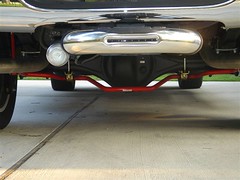
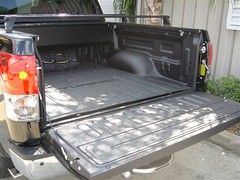
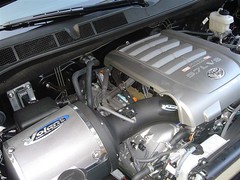
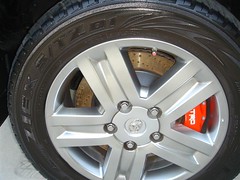
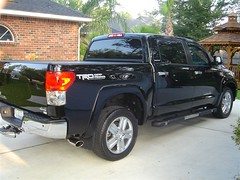
We’ve only got room for a few, but Nachy sent us plenty of photos. You can see them all and get closer detail and explanations.
Even crazier, check out the 152 decible train horn wired into the factory harness that works with the
factory alarm. Yikes! No one is going to steal that truck. Nobody.

Coming soon — TRD Supercharger. As soon as it comes in, Nachy’s going to put it on his truck. Wow. This is the truck we dream about. Really. We dream about trucks. So? Like you don’t.
Nachy — awesome. Just awesome. Our best featured vehicle yet.
New Vehicle Factory Warranties: Toyota Is Last
If you’re considering purchasing a new Toyota, or if you’ve heard anything about Dodge’s new lifetime warranty, you’re probably wondering how Toyota stacks up against the competition.
NOTE: We’ve heard lots of stories about Toyota and others stepping up and replacing parts out of warranty, but since these aren’t official policies they can’t be used as a basis for comparison.
Dodge Factory Warranty: Best Gimmick
In addition to the 3yr/36k mile standard new car warranty, most new Dodges now come with a “Lifetime” powertrain warranty. One reason “Lifetime” is in quote marks is because it’s limited to the first owner. The other reason that “Lifetime” is in quotations is that in order to maintain the warranty, you’re required to have your local Dodge dealership inspect your powertrain exactly every 5 years (at least within 60 days of the purchase date). As if these mandatory inspections weren’t cause for concern, in order to maintain your Dodge “Lifetime” powertrain warranty, quote “It is your responsibility to perform preventative maintenance on your vehicle. You
All Known 2007 Toyota Tundra Problems
Here’s a list of all the known problems with the 2007 Toyota Tundra. We’re not trying to tear the truck down or anything – we love it – we just want to make sure everyone knows what’s going on.
1) 5.7L Camshaft Failures
This is EASILY the most publicized problem with the new Tundra, but we think it was completely been blown out of proportion. Toyota said that this had only happened 20 times. We think it might have been slightly higher than that, but not by much. Since the original news story broke, very little has been heard about any more failures. Many doom sayers predicted the Tundra’s sales would collapse because of this “HUGE” issue, but the Tundra has never sold better. Confidence in Toyota quality remains high, as it should be, and the 5.7 camshaft issue is actually a non-issue.
2) Highway Bed Bounce
This problem is very odd. Because of the specific characteristics of the Tundra’s bed and frame, it is possible to induce a self-amplifying oscillation of the back-end of the truck. Amazingly enough, this can occur at highway speeds as the bed bounces over expansion joints in the roadway. Here’s a video:
Here’s a different video shot on a California highway. At this time, Toyota has not announced a fix. While all trucks exhibit some type of bed bounce on concrete highways with lots of expansion joints, Tundras seem to be worse than normal. Adding weight to the bed and/or a trailer helps, and some other fixes include air suspension and custom leaf springs. The best solution might be to wait and see if Toyota comes up with something official. Finally, if you can drive faster or slower than the harmonic frequency (observed at 55-65 mph) the vibration is vastly reduced. Try using that as an excuse when a cop is writing you a speeding ticket…
3) The stereo shutting off by itself
Of all the problems to have in the world, this one is pretty small. Occasionally, for no apparent reason, a small number of stereos in brand new Tundras have shut off all by themselves. Evidently, this is due to a short in the stereo itself. Toyota is aware of the problem and will replace your stereo as part of the warranty. We’re not 100% sure, but we can’t imagine this problem won’t be fixed in the 2008.
4) One of the air vent’s louvers won’t stay pointed downwards
This problem is actually kind of humorous, so we decided it might be fun to mention. The vent to the right of the driver, due to the effects of air-flow and gravity, has a tendency to creep upwards. In other words, you turn on the A/C, point the vent towards your mid-section, and within a few minutes the louvers have worked themselves upwards so that now the air stream is pointed towards your face. The smartest fix we heard of was to attach a book clip (you know, the black plastic and wire clip) to one of the louvers in such a way to keep it from moving. You could always ask your dealer to fix it, but they would have to remove part of your dash to do so. The book clip seems so much easier.
5) The seatbelt warning chime
A lot of people have complained about the seat belt warning chime. If you take your seat belt off for just a few seconds (say to get out of the truck to get the mail) your warning chime will go off. Also, if you are hauling something in the front passenger seat that weighs more than about 40 lbs, the weight sensor in the passenger seat will think there is a passenger sitting in the seat. If this cargo isn’t buckled in, you’ll get to hear the warning chime. There are lots of solutions to both — check out our article on the Tundra’s annoying seat belt buzzer.
6) Not getting the mileage on the sticker
In our opinion, this issue doesn’t really belong on this list. As long as people buy new vehicles, there will always be some that don’t get the mileage printed on the sticker. First of all, the mileage indicated is an average, meaning half will get more and half will get less. Second, the testing process used to determine those mileage numbers is, well, ridiculous. This isn’t a reflection on Toyota either — the EPA came up with this test nearly 30 years ago. It involves driving VERY slowly with the A/C off and not exceeding 54mph on days ending in “y” with your head cocked at a 17 degree angle…you get the idea. It’s not very applicable to today’s driving. If you’re looking for ways to improve your Tundra’s gas mileage, we wrote about gas mileage earlier this month. But don’t let stories you hear about Tundras getting poor gas mileage scare you off — just know that the mileage printed on the sticker is an estimate.
7) The Tundra is “too nice”
We’ve also heard of new Tundra owners being accused by their relatives (typically domestic truck owning in-laws) of having stuff that was “too nice” and “showing off.” We’re not sure what it is about, but it seems the Tundra gives people the impression that you’re better than them.
Any problems you’ve had that aren’t mentioned here? Tell us about them! We kind of made that last one up btw.

